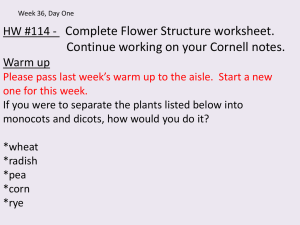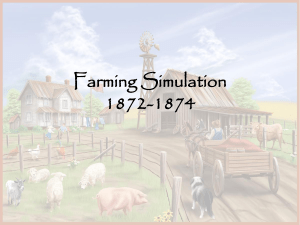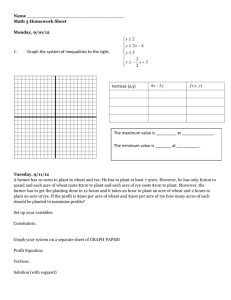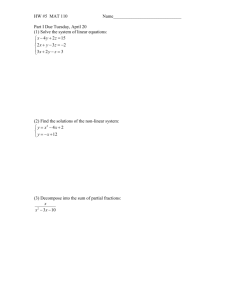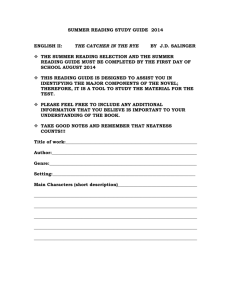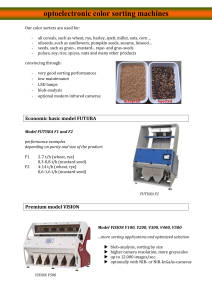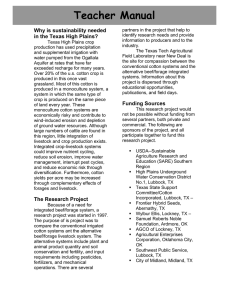Student Workbook Why is Sustainability needed in the Texas High Plains?
advertisement
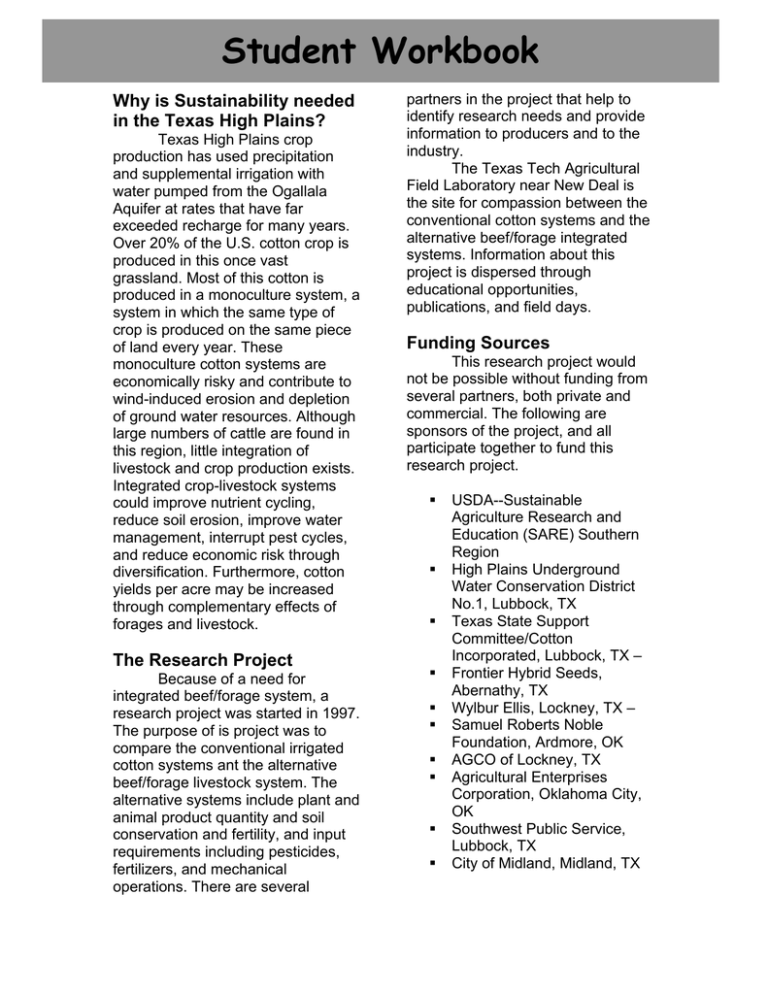
Student Workbook Why is Sustainability needed in the Texas High Plains? Texas High Plains crop production has used precipitation and supplemental irrigation with water pumped from the Ogallala Aquifer at rates that have far exceeded recharge for many years. Over 20% of the U.S. cotton crop is produced in this once vast grassland. Most of this cotton is produced in a monoculture system, a system in which the same type of crop is produced on the same piece of land every year. These monoculture cotton systems are economically risky and contribute to wind-induced erosion and depletion of ground water resources. Although large numbers of cattle are found in this region, little integration of livestock and crop production exists. Integrated crop-livestock systems could improve nutrient cycling, reduce soil erosion, improve water management, interrupt pest cycles, and reduce economic risk through diversification. Furthermore, cotton yields per acre may be increased through complementary effects of forages and livestock. The Research Project Because of a need for integrated beef/forage system, a research project was started in 1997. The purpose of is project was to compare the conventional irrigated cotton systems ant the alternative beef/forage livestock system. The alternative systems include plant and animal product quantity and soil conservation and fertility, and input requirements including pesticides, fertilizers, and mechanical operations. There are several partners in the project that help to identify research needs and provide information to producers and to the industry. The Texas Tech Agricultural Field Laboratory near New Deal is the site for compassion between the conventional cotton systems and the alternative beef/forage integrated systems. Information about this project is dispersed through educational opportunities, publications, and field days. Funding Sources This research project would not be possible without funding from several partners, both private and commercial. The following are sponsors of the project, and all participate together to fund this research project. USDA--Sustainable Agriculture Research and Education (SARE) Southern Region High Plains Underground Water Conservation District No.1, Lubbock, TX Texas State Support Committee/Cotton Incorporated, Lubbock, TX – Frontier Hybrid Seeds, Abernathy, TX Wylbur Ellis, Lockney, TX – Samuel Roberts Noble Foundation, Ardmore, OK AGCO of Lockney, TX Agricultural Enterprises Corporation, Oklahoma City, OK Southwest Public Service, Lubbock, TX City of Midland, Midland, TX Miraco Livestock Water Systems, Grinnell, IA Poole Chemical, Slaton, TX Rushing Family Foundation, Lubbock, TX Diversified Subsurface Irrigation, Lubbock, TX Cyce Stop Valves, Lubbock, TX Water Master, Lubbock, TX Texas Tech University o Office of Research Services o Office of the Dean, College of Agriculture Sciences and Natural Resources o Department of Plant and Soil Science o Department of Agriculture Education and Communications Thornon Endowment, Department of Agricultural Economics Texas A&M University Texas Agricultural Extension Service Natural Resource Conservation Service All of these partners contribute in some way to the project and without their support the project would not be possible. Some of the partners contribute money towards the project, while others contribute supplies such as water valves, irrigation supplies, fertilizer, and watering systems. All of the partners contribute to the project because they all have an interest in the project and what it can do for agriculture in the Southern High Plains. The partners are concerned about the environment and are very concerned with the lowering of the Ogallala Aquifer. The partners to the project are all excited about the project and its results. Objectives of the Project The overall objective is to develop environmentally sustainable and economically feasible crop and livestock systems that will assure the viability of agricultural activities in the Southern High Plains. Specific objectives include: 1. To compare productivity, profitability, and impact on natural resources of continuous cotton systems, all forage-livestock system, and an integrated cotton/forage/livestock system. 2. To involve local producers and industry in identifying researchable needs, in developing and testing systems of production, in the development of more effective dissemination of information to end users, and enhanced adoption of new technologies. With the objectives of the project it is seen that the project will show if an integrated crop/livestock system will, in terms of the environment and economics, be better suited for this area, rather than monoculture cotton. How the Project is Set Up Referring to the map and layout of the project, it can be seen that there are three systems that are replicated. For example, one system is composed of a pasture of WW-B. Dahl, a plot containing a rotation of rye/cotton/wheat, a plot of continuous cotton, and a plot containing a rotation of wheat/fallow/rye. There are three of these systems contained in the research project. The reason that there are three systems present is because with more systems you will have better results from research. With just one system, the results would not be as accurate as they will be with three systems present. In the continuous cotton plot, cotton is planted in the spring and stripped in the fall every year. Also, in this plot wheat is planted in the furrow bottoms each fall to reduce soil erosion. Water use, fertilizer use, cotton yields, profits, and several other forms of data are collected on this plot throughout the year. In the alternative system, 500pound steers are bought in early January and graze stockpiled WWB- Dahl grass. In mid-April these steers are supplemented with small grains by being allowed to graze the rye in the rye/cotton/wheat plot. When the rye starts to run out, the wheat from the wheat/fallow/rye plot is ready for grazing. The cattle are then allowed to graze the wheat, usually for 30 days, until the WW-BDahl grass is ready to be grazed again. The cattle graze the WW-BDahl grass in the summer months until around mid-July when they are moved to the feedlot. For a better understanding of what is happening in each plot of the alternative systems, following is a month-by-month description of the project: January WW-B-Dahl: dormant and newly purchased cattle are grazing it. Rye/cotton/wheat: rye is growing, but not ready for grazing Wheat/fallow/rye: wheat is growing, but not ready for grazing February WW-B-Dahl: dormant and cattle are grazing it. Rye/cotton/wheat: rye is growing, but not ready for grazing Wheat/fallow/rye: wheat is growing, but not ready for grazing March WW-B-Dahl: dormant and cattle are grazing it Rye/cotton/wheat: rye is growing, but not ready for grazing Wheat/fallow/rye: wheat is growing, but not ready for grazing April WW-B-Dahl: cattle continue to graze for the first part of the month Rye/cotton/wheat: rye is maturing and ready for grazing the last part of the month Wheat/fallow/rye: wheat is growing, but not ready for grazing May WW-B-Dahl: cattle are off and the grass is rested and allowed to begin new spring growth Rye/cotton/wheat: in early May, the rye is terminated with Round Up and Round Up Ready cotton is planted Wheat/fallow/rye: cattle graze wheat after they are moved off of the rye June WW-B-Dahl: after the wheat is grazed out, the cattle are moved to the grass Rye/cotton/wheat: cotton is growing Wheat/fallow/rye: cattle graze the wheat until it is exhausted, usually about 30 days, then are moved to the B-Dahl grass July WW-B-Dahl: cattle graze the growing grass, cattle are pulled off of the grass in late July and taken to a feedlot for finishing Rye/cotton/wheat: cotton is growing Wheat/fallow/rye: the land in this plot is fallowed until rye is planted in September August WW-B-Dahl: grass is allowed to mature and go to seed Rye/cotton/wheat: cotton is growing Wheat/fallow/rye: land is fallowed September WW-B-Dahl: grass is allowed to mature and go to seed Rye/cotton/wheat: cotton is growing Wheat/fallow/rye: rye is planted October WW-B-Dahl: grass seed is harvested Rye/cotton/wheat: cotton is growing Wheat/fallow/rye: rye is growing November WW-B-Dahl: grass is dormant Rye/cotton/wheat: cotton is harvested and wheat is no-till drilled into the cotton stubble Wheat/fallow/rye: rye is growing December WW-B-Dahl: grass is dormant Rye/cotton/wheat: wheat is growing Wheat/fallow/rye: rye is growing The same rotations are happening in each one of the three systems that are set up. Research data from each system is gathered throughout the year. Furthermore, in each system, recommended practices of all applications of herbicides and pesticides are followed. Detailed descriptions of the different types of crops in the systems will be covered in future lessons. What components are needed for the research project and why? There are several components of the research project that would not be normally used on a farm, but are needed for the research project. Irrigation system: Some producers are putting in sub-surface drip irrigation to conserve water, but most still use pivots for irrigation. The reason that sub-surface drip irrigation is used for this research project is that amounts of water applied to crops can very accurately be measured. With pivots some water is lost to evaporation, so with the sub-surface drip irrigation, researchers are hoping to know exactly how much water is being applied. Fencing: Since there are three systems that are exactly the same, there is a lot of fencing that is needed. Also, as you can see by the month-to-month rotations, the cattle move around quite a bit, so adequate fencing is needed. This project uses permanent hogwire/barbwire fencing, uses three-wire high tensile fences to fence off some areas, and uses three-wire poly tape to fence off other areas. Since the project is always changing and there is so much area that needs to be divided, it is important that some of the fencing, like the polywire, be portable so that it can be moved as the project changes. Water: We all know cattle have to have water to survive, so watering troughs are set up in several plots so that no matter where the cattle are, they will have water. Most of the time, a single tank will work for water, but with the research project and the need for several different plots, a number of tanks are needed. Weather Monitoring: Since researchers are very careful and want to be extremely accurate in knowing how much water they put on the system, rain and weather needs to be monitored just as accurately. Through knowing exactly what is going on with the weather and rainfall, better management decisions can be made. What are some of the pros of this research project? _____________________________ _____________________________ _____________________________ _____________________________ _____________________________ What are some of the cons of the system? _____________________________ _____________________________ _____________________________ _____________________________ _____________________________
